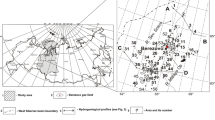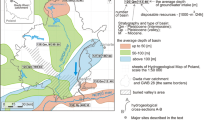Abstract
Groundwater quality is determined by a variety of factors. Petrographic properties of the rocks in the vadose and in the groundwater saturated zones as well as the regional hydrological and hydrodynamic conditions are regarded as its major natural influencing factors together with groundwater’s initial composition. For an assessment of major groundwater composition on a continental scale, the complexity of individual aquifers needs to be organized into simplified patterns. For this purpose, European scientists, among them representatives from several European national geological surveys, jointly defined a harmonized European aquifer typology, which includes the major classes of aquifers showing comparable petrographic properties. This process has led to the development of the European aquifer typology map presented in this paper. Similar groundwater compositions are expected for the various classes in comparable hydrodynamic and hydrologic conditions. Application of the aquifer typology with regard to the intercomparison of hydrochemical data sets across Europe for several aquifer types clearly points out that typical groundwater compositions can be distinguished for the various aquifer types. In the future this typology may serve as a basis for referencing hydrogeochemical groundwater composition on a European scale.

Similar content being viewed by others
References
Appelo CAJ, Postma D (2005) Geochemistry, groundwater and pollution, 2 edn. Taylor & Francis, London, p 649
Campbell N, D’Arcy B, Frost A, Novotny V, Sansom A (2004) Diffuse pollution: an introduction to the problems and solutions. IWA Publishing, London
CEC (1982) Groundwater resources of the European Community Synthetical report. Brussels, Luxemburg, p 75
De Marsily G (1986) Quantitative hydrogeology. Academic, INC, London, p 440
Frind EO, Duynisveld WHM, Strebel O, Boettcher J (1990) Modeling of multicomponent transport with microbial transformation in groundwater: the Fuhrberg case. Water Resour Res 26(8):1707–1719
Gilbrich WH (2000) International hydrogeological map of Europe. Feature article, Waterway No. 19, Paris, p 11
GWDD (2006) Directive of the European parliament and of the council on the protection of groundwater against pollution (COM (2003) 550)
Hiscock KM, Lloyd JW, Lerner DN (1991) Review of natural and artificial denitrification of groundwater. Water Res 25:1099–1111
Hollis JM, Holman IP, Burton RGO (2002) A digital data set of European water resources at 1:500.000. http://www.eusoils.jrc.it/ESDB_Archive/groundwater/docs/EUGWFR.pdf
IGRAC International GROUNDWATER RESOURCES ASSESSMENT CENTRE (2005) Proposed groundwater provinces. info@igrac.nl
Müller D, Blum A, Hart A, Hookey J, Kunkel R, Scheidleder A, Tomlin C, Wendland F (2006) Final proposal for a methodology to set up groundwater threshold values in Europe. Specific targeted EU—research project BRIDGE—report D 18
Panagopoulos A, Lloyd J, Fitzsimons V (1995) Groundwater evolution of the Tirnavos alluvial basin, central Greece, as indicated by hydrochemistry. Proc 3rd hydrogeological conference, Hellenic Chapter of IAH, Heraklion, pp 332–344
Plant J, Smith D, Smith B, Williams L (2001) Environmental geochemistry at the global scale. Appl Geochem 16:1291–1308
Postma D, Boesen C, Kristiansen H, Larsen F (1991) Nitrate reduction in an unconfined sandy aquifer—water chemistry, reduction processes and geochemical modelling. Water Resour Res 27(8):2027–2045
Struckmeier WF, Gilbrich WH, Gun Jvd, Maurer S, Puri S, Richts A, Winter P, Zaepke M (2006) WHYMAP and the groundwater resources map of the world at the scale of 1:50 000 000. Special edition for the 4th world water forum, Mexico City, March 2006. BGR Hannover/UNESCO, Paris
Van den Brink C, Frapporti G, Griffioen J, Zaadnoordijk WJ (2007) Statistical analysis of anthropogenic- versus geochemical-controlled differences in groundwater composition in the Netherlands. J Hydrol (in press)
Wendland F, Hannappel S, Kunkel R, Schenk R, Voigt HJ, Wolter R (2005) A procedure to define natural groundwater conditions of groundwater bodies in Germany. Water Sci Technol 51(3–4):249–257
Wendland F, Berthold G, Blum A, Elsass P, Fritsche HG, Kunkel R, Wolter R (2007) Derivation of natural background levels and threshold values for groundwater bodies in the Upper Rhine Valley (France, Switzerland and Germany). Desalination (in press)
WFD (2000) Richtlinie 2000/60/EG des Europäischen Parlaments und des Rates zur Schaffung eines Ordnungsrahmens für Maßnahmen der Gemeinschaft im Bereich der Wasserpolitik (Wasserrahmenrichtlinie) vom 22 December 2000, Luxemburg
Wyns R, Baltassat JM, Lachassagne P, Vairon J, Mattieu F (2004) Application of proton magnetic resonance soundings to groundwater reserve mapping in weathered basement rocks (Brittany, France). Bull Soc Geol Fr 175(1):21–34
Acknowledgments
The groundwater monitoring data sets, provided by national research bodies and the national water authorities, like the Flemish Environmental Agency (VMM), are greatly appreciated. Same is true for the results of statistical evaluations of groundwater analyses provided by national and regional studies. The contents of this paper have been compiled in the framework of the EU-specific targeted research project “BRIDGE” (Background cRiteria for the IDentification of Groundwater thresholds). The views expressed in the paper are purely those of the writers and may not in any circumstances be regarded as stating an official position of the European Commission.
Author information
Authors and Affiliations
Corresponding author
Rights and permissions
About this article
Cite this article
Wendland, F., Blum, A., Coetsiers, M. et al. European aquifer typology: a practical framework for an overview of major groundwater composition at European scale. Environ Geol 55, 77–85 (2008). https://doi.org/10.1007/s00254-007-0966-5
Received:
Accepted:
Published:
Issue Date:
DOI: https://doi.org/10.1007/s00254-007-0966-5




